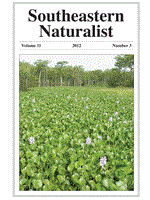We provide a review of Dasypus novemcinctus (Nine-banded Armadillo) food studies and report on the diet on Cumberland Island, GA. Major invertebrate foods eaten by Armadillos on Cumberland Island were ants (19.3%); beetles, adults and larvae (27.4 %); centipedes (6.5%); lepidopterans, mostly larvae (caterpillars, 13.2%); millipedes (5.7%); spiders (2.1%); and sowbugs (2.2%). Vertebrates eaten (1.9% volume) were mostly frogs and lizards. Plant material comprised about 12% of the volume, including much fruit such as Melia azedarach (China Berry), Vitis (grapes), Ampelopsis arborea (Pepper Vine), and Serenoa repens (Saw Palmetto). The subterranean fungi, Endogonaceae, were eaten by 23.9% of the Armadillos, comprising 1.6% of the volume of their diet. The millipede Narceus sp. appears to have been greatly reduced, based on the significant reduction of this species as a component of the gut content over three decades. This reduction could be due to Armadillo predation. Ants, scarabaeid adults and larvae, and spiders also showed significant decreases during the period of study, which could be a result of Armadillo predation. A number of items—elaterid larvae, crickets, caterpillars, centipedes, sowbugs, and Endogonaceae—showed significant increases as components of Armadillo stomachs, but it is not known whether these changes might be related to Armadillo predation. The increases could have been due to other causes such as habitat or climatic changes.
How to translate text using browser tools
1 September 2012
Food of the Armadillo Dasypus novemcinctus L. from Cumberland Island, GA
John O. Whitaker,
Carol Ruckdeschel,
Laura Bakken
ACCESS THE FULL ARTICLE

Southeastern Naturalist
Vol. 11 • No. 3
September 2012
Vol. 11 • No. 3
September 2012




